In this article we are going to understand foreign currency valuation, foreign currency translation and how exchange rate difference amount is treated while clearing of open item.
Every month end, financial reports need to be prepared for local authority in local currency as well as for group consolidation in group currency.
Foreign currency valuation is about valuating transaction currency amount into local currency amount. Foreign currency translation is about valuating local currency into group currency. Let’s discuss both one by one.
Foreign currency valuation: (Transaction currency to local currency)
Organizations do have transaction in foreign currency. When document is entered in foreign currency (document currency other than company code currency), local currency amount is derived by using currency exchange rate existing at the time of document posting. But later on exchange rate might change hence amount in local currency derived using exchange rate at the time of reporting will not be same as local currency amount in posted document. Impact of exchange rate changes needs to be taken into account by posting adjustment entries.
Example:
Company code currency: INR
Group currency: USD
Example 1: On 5th August, I posted vendor invoice of 100 GBP.
♦ Currency exchange rate on 5th August: 65 INR = 1 USD & 1GBP= 1.3 USD
(Currency exchange rate type has reference currency USD)
Vendor invoice is posted in below currencies:

Let’s say month end report is to be prepared on 31st August
♦ Currency exchange rate on 31th August: 70 INR = 1 USD & 1GBP= 1.5 USD
(Currency exchange rate type has reference currency USD)
To arrive at exact position of the day of reporting, below adjustment accounting entry should be posted:

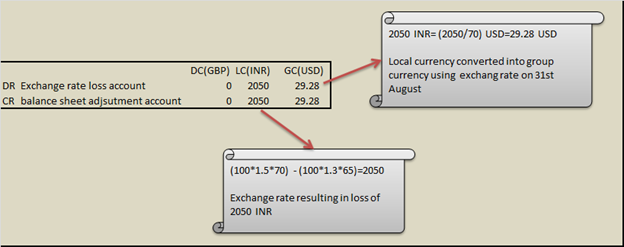
This step of posting adjustment entry is referred as foreign currency valuation. Hence foreign currency valuation is needed to incorporate the impact of exchange rate changes.
Adjustment accounting entry is posted to get the exact position of balance sheet on the day of reporting. Since this exchange rate gain/loss is unrealized (hypothetical) hence adjustment accounting entry is reversed with posting date in next month.
Standard practice is to run foreign currency valuation on last day of the month which post adjustment accounting entry on last day of the month and reverse the same on first day of next month.

Foreign currency translation: (Local currency to group currency)
Once foreign currency valuation is complete, foreign currency translation is executed to prepare financial report in group currency for consolidation purpose.
Consider the same above example, foreign currency translation is executed on 31st August
Below document gets posted as a result of foreign currency translation


Adjustment accounting entry is posted to get the exact position of balance sheet on the day of reporting in group currency. Since this exchange rate gain/loss is unrealized (hypothetical) hence adjustment accounting entry is reversed with posting date in next month.
Standard practice is to run foreign currency translation on last day of the month (after foreign currency valuation is complete) which post adjustment accounting entry on last day of the month and reverse the same on first day of next month.
Till now we have been discussing about unrealized gain/ loss which gets originated due to change in currency exchange rates. So the next question, what happens to the realized exchange gain/loss amounts when open item is cleared?
How sap treats realized exchange rate difference amount?
Example:
Let’s say vendor payment is being done on 10th September.
♦ Currency exchange rate on 10th September: 72 INR = 1 USD & 1GBP= 1.6 USD
(Currency exchange rate type has reference currency USD)
Payment amount is 100 GBP.
Invoice will get cleared with payment document and an adjustment accounting entry will get posted as below


In this example, impact of exchange rate change is realized (vendor open item has been cleared) hence no need to post reversal of adjustment accounting entry. Reversal entry is posted for unrealized exchange gain or loss.
What are the accounts relevant for foreign currency valuation?
Accounts which are managed on open item basis and have foreign currency transaction. E.g. clearing accounts, GR/IR clearing account, reconciliation account etc.
Accounts which are not managed as open item and have foreign currency transaction e.g. Bank accounts, sales account etc.
What configuration is needed for foreign currency valuation and translation?
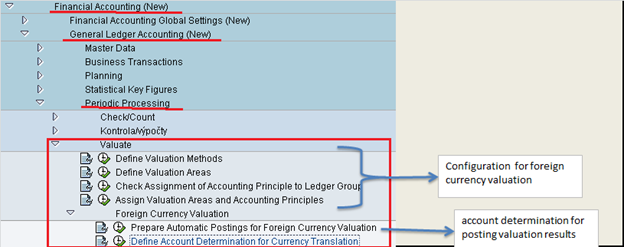
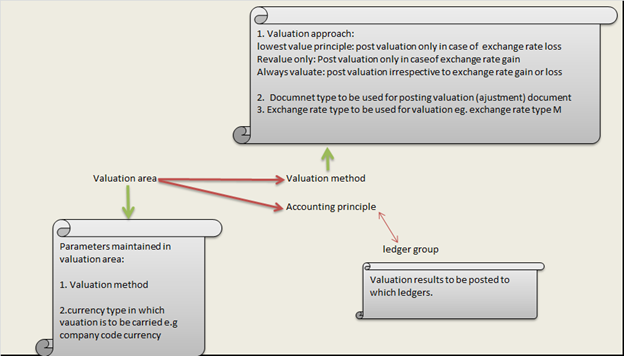
Below shows place where account determination is maintained for accounts which are managed on open item basis:
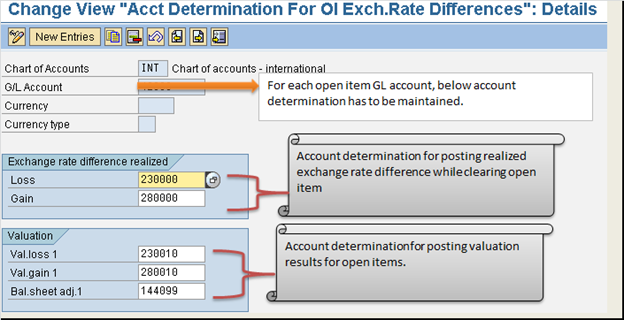
Account determination for GL accounts which are not managed on open item basis but are relevant for foreign currency valuation.
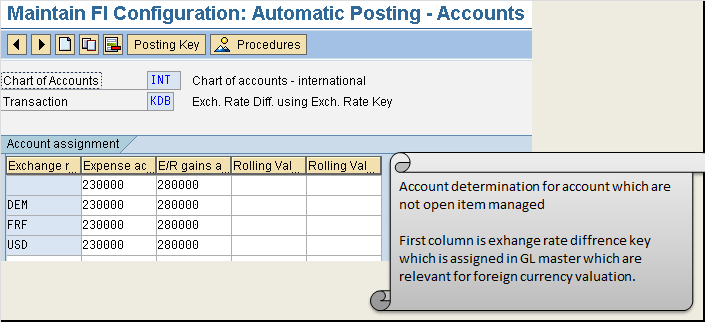
GL ACCOUNTING
- What is SAP FICO ?What business requirement is fulfilled in this module?
- What is enterprise structure in sap fico?
- What is GL account? What is account group? What is operational chart of accounts?
- What is the need of country chart of account or alternate chart of account? How country chart of account helps fulfill a business requirement?
- What is the need for group chart of account? How group chart of account helps in consolidation of financial data?
- What is non leading ledger in sap fico?
- What is company code global settings? What global parameter is assigned to company code?
- What is fiscal year variant? Why fiscal year variant is assigned to company code?
- What is posting period variant? Why posting period variant is assigned to company code?
- What is field status variant? What is field status group?
- What is document type in sap? Explain the purpose of document type?
- Document date vs Posting date vs Entry date vs Translation date. Explain
- What is posting key? what is the use of posting key?
- Document header & line items capture information of business transaction.
- Everything about currency & exchange rate in sap.
- Foreign currency valuation in sap. Explain with example
- Retained earnings account helps in year end balance carry forward. Explain
- What is the significance of tolerance groups in sap?
- What parameters are maintained in GL master and how does it impact in document posting?
ACCOUNTS PAYABLE
- What is meant by accounts payable in sap?
- Understanding procure to pay (PTP) cycle and accounting document at each step.
- Understanding MM FI integration in very simple terms.
- Purchase order price determination in SAP. Explained in very simple words.
- House bank, Bank key, Account ID in SAP
- What configuration (FBZP) needed for executing F110 in sap ?
ACCOUNTS RECEIVABLE
- How sap overcomes challenges in accounts receivable process?
- What is customer reconciliation account?
- Understanding order to cash cycle in sap.
- Understanding SD FI integration in very simple terms.
- What is lock box? How lockbox helps in collection from customers?
TAX ACCOUNTING
- How sap helps in tax accounting?
- Tax configuration in sap: Tax procedure, Tax code & Tax jurisdiction code
- Concept of tax jurisdiction code & tax jurisdiction structure
- Significance of “Tax category & Posting without tax allowed” in GL master.
- Tax base amount and Discount base amount
- Assigning tax code V0 & A0 for non taxable transaction?
- Deductible input tax vs non deductible input tax
WITHHOLDING TAX
- Withholding tax in sap explained with example.
- How sap overcomes challenges in managing withholding tax?
- Withholding at the time of invoice or payment
- Withholding tax configuration in sap
- Business place & Section code in sap
- Withholding tax certificate numbering in sap
- Withholding tax report for filling tax returns
ASSET ACCOUNTING
- How sap helps in asset accounting?
- What is meant by asset accounting?
- What is the use of asset class?
- What is the use of depreciation key in asset accounting?
- Depreciation area and Chart of depreciation in sap.
- Derived depreciation area VS real depreciation area?
- Understanding asset accounting configuration needed in sap
- GL account determination for posting asset transaction
- Asset transaction and corresponding accounting document?
- How depreciation is posted in sap?
SAP CONTROLLING